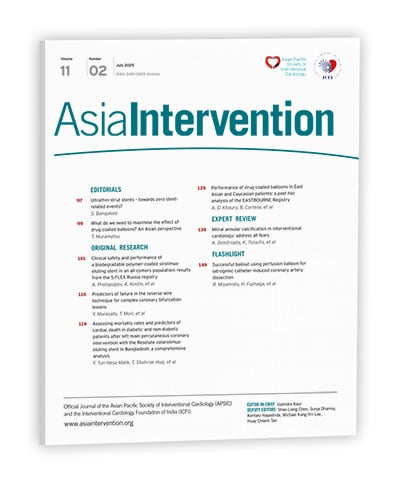Dear Colleagues,
Welcome to the 2nd issue of 2025 of the journal. As you know, AIJ now publishes 3 issues per year. Its popularity and ratings are increasing, and we are hoping to receive the much-awaited impact factor.
This issue starts with an all-comers registry from Russia on an ultrathin biodegradable-polymer, sirolimus-eluting stent from India – the “Supraflex Cruz” − by Alexey Protopopov, Andrey Kostin et al. The results of this registry, which included complex cases, are very gratifying with a target lesion failure (TLF) rate of only 3.1%, including just one case of stent thrombosis at 1 year. The TLF remained low in all the complex situations such as diabetes, bifurcations, and long lesions. The predecessor of this stent, the Supraflex, demonstrated equivalence with the well-known durable-polymer, everolimus-eluting drug-eluting stent (DES) XIENCE in the TALENT study in 2021. Following this, the improved version, the Supraflex Cruz, has been evaluated in several clinical trials, including the Functional Versus Culprit-only Revascularization in Elderly Patients with Myocardial Infarction and Multivessel Disease (FIRE) trial and the COMPARE 60/80 HBR trial, again proving equivalence. There are two more large ongoing studies on comparing the Supraflex Cruz with the SYNERGY DES in multivessel disease (Multivessel TALENT), as well as TUXEDO-India 2, comparing it with XIENCE in diabetic patients with multivessel disease. Therefore, the S-FLEX Russia registry is an important addition to the database of this new DES. Sripal Bangalore, in an editorial on this stent, has reiterated the advantages of this ultrathin-strut DES and its promises in complex percutaneous coronary intervention (PCI). He postulates that the thinner struts and better polymer lead to lower inflammation, faster re-endothelialisation, and laminar flow around the struts reducing the risk of stent thrombosis/restenosis. However, it is not clear whether making struts even thinner would provide any incremental benefit.
The next article is a technical procedure for crossing the side branch of complex bifurcation lesions using the reverse wire technique or a main branch blocking technique (BBT) with a coronary balloon in case of failure. The authors, Yoshinobu Murasato, Takahiro Mori et al, report severe tortuosity, calcification, and small vessels as risk factors for failure where the BBT technique succeeded.
Fazila Tun-Nesa Malik, Tawfiq Shahriar Huq et al, in the next article, report their 10-year experience of left main stenting in a single high-volume centre in Bangladesh and compare the results of patients with diabetes with the non-diabetic group using the Resolute zotarolimus-eluting DES in a relatively young population. The results are very impressive with low cardiac and all-cause mortality in both groups. In the small number of patients who died during the follow-up of around 6 years, age, adverse renal function and procedural variables like inadequate post-dilatation were the only significant variables. It is noteworthy that these results go against the well-known observation that diabetic patients have higher mortality than non-diabetic patients, as established in trials like SYNTAX and EXCEL. While SYNTAX used the first-generation paclitaxel-eluting stent, EXCEL used XIENCE, a well-accepted, new-generation stent. The single-centre study with extensive experience and a very good selection of cases under supervised medical treatment has been given as a reason for the exceptionally good results, with diabetic and non-diabetic patients performing equally well. These results, however, need to be duplicated in a larger prospective study before concluding that diabetics perform equally well. Nevertheless, the authors should be congratulated for producing comparable results in a diabetic population. I am certain these results will raise a few eyebrows.
Next, you will come across a substudy of the EASTBOURNE study showing the efficacy of a sirolimus-coated balloon. The authors, Antoine El Khoury, Bernardo Cortese et al, performed propensity-based matching and compared the Caucasian population with the East Asian population recruited in the study. They found in their analysis that Caucasians had a higher rate of target lesion revascularisation, but this did not result in higher major adverse cardiovascular events or all-cause death, although they had a lower bleeding risk. These findings need confirmation, including whether this finding is specific to sirolimus. It could also mean that the operators, for some reason, achieved better outcomes in the non-Caucasian population by more frequently adhering to the basic principles of drug-coated balloon PCI. However, this population division for analysis does not seem to be a predefined subset of the EASTBOURNE study. Takashi Muramatsu, in his editorial, has also noted that it appears that better lesion preparation seems to be the key to better results in the non-Caucasian patients, and in this regard, a scoring balloon, intravascular imaging and use of fractional flow reserve during the procedure may further improve the results. He also comments on the “East Asian paradox”, in which Asians are generally more susceptible to bleeding complications than thrombotic events, despite a higher prevalence of the CYP2C19 gene mutation which substantially affects drug metabolism.
This is followed by a review article on the technical challenges in carrying out non-surgical treatment of mitral regurgitation complicated by mitral annular calcification. Kyriakos Dimitriadis, Konstantinos Tsioufis et al discuss various procedures in this setting, as well as the challenges associated with them.
The use of a perfusion balloon to manage a flow-limiting dissection was a bailout method during the initial years of balloon angioplasty, before the availability of bare metal stents and covered stents. These balloons, which could maintain optimal flow from the holes proximal to the balloon to the distal part of the shaft, used to be part of the catheterisation laboratory inventory. The interventional flashlight by Ryota Miyamoto, Hiroyuki Fujinaga et al has used the same concept in salvaging their patient in the present era for a major dissection near the left anterior descending artery ostium − “old wine in a new bottle”.
I do hope you find the contents of this issue educative and thought-provoking. I would appreciate it if you and your colleagues make AIJ your journal of choice to submit manuscripts. We, at our end, will do our best to expedite the review process.
Happy reading,
Upendra Kaul, Editor-in-Chief

